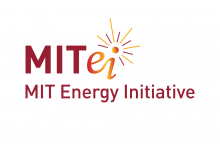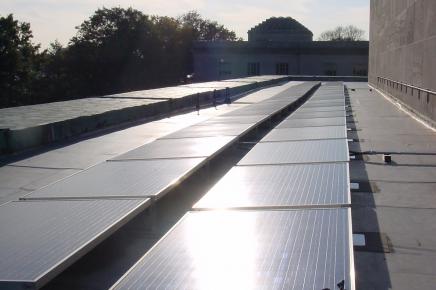
MIT is world-renowned for its broad expertise in energy-related research, education, and invention. At the MIT Office of Sustainability (MITOS), we’re helping to leverage that knowledge to create a more sustainable, energy efficient, and high-performing campus, continuing a long tradition of energy efficiency.
Building on history, moving toward a sustainable future
In 1916, MIT designed, installed, and generated a state-of-the-art district utility system, which allowed the Institute to forego the installation of small-scale furnaces all across the campus. Over the last century, MIT has continued to prioritize energy efficiency - and more recently, renewable energy - across several project areas, which can be explored below. In 1995, MIT expanded its central utility plant to provide a natural gas-fired heat and power system to produce electricity and steam using co-generation, a process in which heat that would otherwise be lost out of the exhaust stack is captured and reused. The continual use of cogeneration enables the Institute to create a flexible power system that can adapt and evolve in response to advances in the energy field.
In 2016, MITOS and the MIT Department of Facilities worked with partners across campus to form an alliance with Boston Medical Center and Post Office Square Redevelopment Corporation, enabling the construction of a 650-acre, 60-megawatt solar farm. MIT is purchasing 73 percent of the power generated by the new array, neutralizing 17 percent of the campus’ carbon emissions and demonstrating a commitment to developing renewable energy options.
In 2017, MIT broke ground on an upgrade project to revitalize its Central Utilities Plant (CUP), a distributed energy resource (DER) that powers the campus microgrid with thermal and electric energy. The CUP upgrade is essential to the Institute’s sustainability goals and will improve campus resiliency by creating an enhanced, more efficient, and more flexible power system. This in turn supports efforts in Massachusetts and neighboring states to build overall resiliency across the Northeast.
The upgraded plant, which uses advanced cogeneration technology, became fully operational at the end of 2021 and is meeting campus energy needs at greater efficiency and lower carbon intensity (on average 15 to 25 percent cleaner) compared to the regional electricity grid. Carbon reductions from the increased efficiency provided by the enhanced plant are projected to counter the added greenhouse gas emissions caused by recently completed and planned construction and operation of new buildings on campus, especially energy-intensive laboratory buildings.
Energy from the plant is delivered to campus buildings through MIT’s district energy system, a network of underground pipes and power lines providing electricity, heating, and air conditioning. With this adaptable system, MIT can introduce new technologies as they become available to increase the system’s energy efficiency. The system enables MIT to export power when the regional grid is under stress and to import electricity from the power grid as it becomes cleaner, likely over the next decade as the availability of offshore wind and renewable resources increases.
Improved campus resiliency at MIT takes the pressure off the region’s utility grid — a system experiencing increasing demands and the growing frequency of severe weather events. The flexibility of MIT’s system is based in part on the fact that the campus microgrid can be coupled with the regional grid or can run independently as needed. MIT’s ability to operate on self-generated power in emergencies will help local utilities meet customer demand and provide more reliable services.
MITOS is currently working collaboratively to transform the campus energy systems via operations, education, research, and innovation in the following areas.
MIT has a number of small-scale, on-site solar energy systems on its campus. These systems provide locally generated electricity and also offer opportunities for research and academic initiatives.
The Office of Sustainability has partnered with the Department of Facilities to explore and maximize features and strategies to enhance efficiency, support demand-side reduction, and advance climate action in upgrades to the Central Utilities Plant.
MITOS continues to gather a preliminary picture of MIT’s Scope 3, or indirect, greenhouse gas (GHG) emissions in order to inform MIT’s total GHG emissions activities (Scopes 1 + 2 + 3) and explore where strategic opportunities may exist to reduce emissions.
MITOS is part of a community of departments, labs, and centers working toward elements of a sustainable campus. Featured below are initiatives from some of our partners.

Collaborative research from the MIT Energy Initiative with industry and government in key technology areas to address climate change.

Mission: Leverage high-performance PV to enable qualitatively novel system-level functionality.

The Center for 21st Century Energy is dedicated to developing technologies for a sustainable energy future.

Through an interdisciplinary approach to the so-called ‘energy efficiency gap’, the center seeks to evaluate and strengthen policies and incentives for improved energy efficiency.
The Department of Facilities is a key partner in all aspects of our campus energy work from designing and operating our Central Utility Plant as cleanly and efficiently as possible, to implementing campus-wide energy efficiency projects across campus.
The MIT Energy Initiative through supporting campus energy activities, educational opportunities, and outreach has helped inform and shape the work we do.
The Center for Energy and Environmental Policy Research is helping to shape the financial analysis of a portfolio of energy projects for reducing campus greenhouse gas emissions.
Office of the Vice President for Finance is a tremendous resource for many project areas including the analysis and due diligence review of off-campus renewable energy projects, green bonds, and greenhouse gas emissions inventory auditing.






